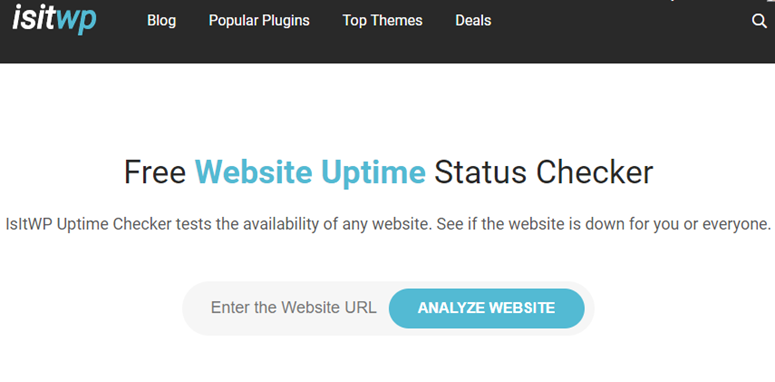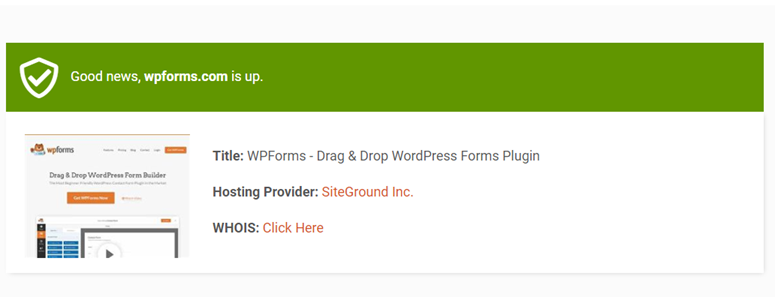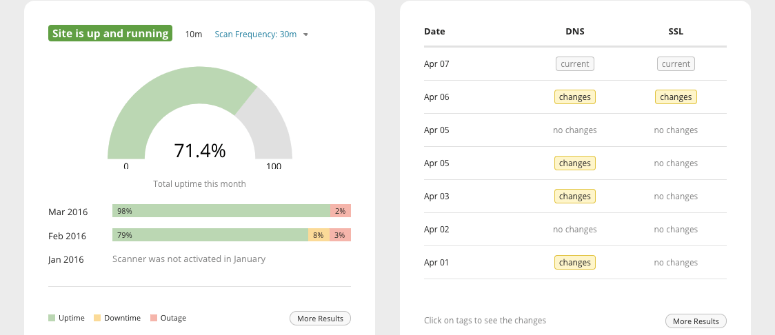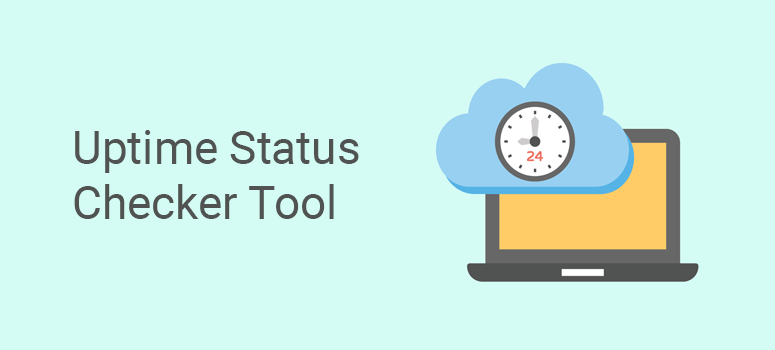Website Uptime Checker
At IsItWP, we’ve developed a free online tool to help you test whether your website is down for everyone or just for you. It’s the easiest way to test your site status.
What Is Website Uptime?
Site uptime refers to when your website is online and working as it should. It’s usually shown as a percentage, like 99.95%, indicating how much of the time your site was accessible.
The dream is 100% uptime, where your site runs flawlessly 24/7 all year. But in reality, achieving that is tough due to occasional hiccups.
Factors That Affect Your Web Page Status
Before you check your website status, you need to understand what affects the uptime. This will help you work on these site elements so you can improve them after running tests.
With that in mind, here are factors that can affect your web hosting server’s uptime:
- Technical glitches: Think hardware breakdowns or power cuts.
- Human slip-ups: Errors during server updates or maintenance.
- Security risks: Hackers or cyberattacks targeting your site.
- Natural events: Disasters like storms or floods hitting the server’s location.
- Backup corruption: Corrupted backups that fail when you need them.
These challenges explain why no hosting provider can promise 100% uptime. That said, anything below 99.9% is generally seen as unreliable.
Want to see how hosting providers compare on uptime? Check out our full web hosting review for the details.
How Does IsItWP Uptime Checker Work?
IsItWP’s free website uptime status checker is the best way to analyze whether your website is down for everyone or just you.
Here’s how our uptime checker works:
1. Submit Your URL to Our Uptime Checker Tool
To test your website availability, all you have to do is enter your site’s URL in our Website Uptime Status Checker tool above and click the Analyze Website button.

2. Our Tool Monitors Your Site’s Uptime
After your website URL is submitted, our free website uptime status checker tool checks whether your website is available to visitors.
3. You Get the Result
Once the tool runs its checks, you’ll immediately get the uptime status test results. You do not need to refresh the page or redirect to a different screen; both the test and results run on the same page.
We made our uptime site tester work like this to make it super simple for you. You can quickly see the results after the check, conveniently on the same page, allowing you to act on improvements.
Alongside, your uptime results, you also find out the following details of the site you’re testing.
- The latest screenshot of the site offers you a quick visual check
- Title of the site to confirm your site’s identity and SEO readiness.
- Hosting provider where the site is hosted sheds light on the backbone of your site’s performance
- Whois info of the domain name provides transparency about the domain itself

Well done! That’s how easy this website status test tool is to use. You don’t need any expert knowledge or premium tools.
Website Downtime and Consequences
In order to understand the importance of website uptime, we need to discuss what happens if your site goes down for a few minutes.
So, what actually happens when your site is down?
Downtime Sabotages Your Online Reputation
Nothing destroys your online reputation faster than having your website unreachable to your potential visitors.
Your customer expects your website to stay operational around the clock. When your website is down, it hurts the trust of your audience, and they see that your website is unreliable.
If you experience frequent outages, then it’s in your best interest to switch over to a reliable WordPress hosting provider.
Downtime costs you sales and revenue
Website outage directly translates into lost sales and revenue. Your customers won’t be able to purchase your products as long as the outage lasts.
To help you with this, we have created another free web tool to calculate the actual downtime cost. This will help you answer the question “How much money you are losing when your site goes down?”
Impacts Your SEO
Having frequent downtimes can also affect your website’s SEO negatively.
When you have frequent downtimes, Google sees that your website is unreliable. Obviously, they don’t want to send users to a website that is unreliable because it provides their users with a bad experience.
This can be really frustrating, as you might have implemented the best SEO practices, but your site is still not performing.
My Website Is Down. What Should I Do Next?
You have run your site through our free uptime checker and found out it is not working. So what do you do next?
As experienced WordPress experts, we don’t just want to show you the issues your WordPress website is facing; we want to help you fix them.
So, simply follow the step-by-step guide below to figure out why the outage occurred and get the site back online.
1. Verify Yourself – Is It Really Down Right Now?
First things first, before you conclude that your site is down, it’s worth taking a moment to ask yourself, is it down for everyone or just me?
Using our free website uptime status checker is the best way to verify if your website is actually down for everyone or just you. To conduct the website availability test, all you have to do is specify your website URL and hit the Analyze Website button.
That’s it!
Once your URL is submitted, our system will ping your site and tell you whether your site is available or not.
2. Is your site available to other people?
It is not uncommon for your site to be just unavailable to you. You might have internet connection issues, firewall blocking, DNS problems, or browser cache issues.
So, it is important to find out this before any further steps.
To find out if your site is available for everyone but not for you, follow these steps below:
Check your site in incognito mode:
- The easiest step is to access the website using incognito mode from your browser. If you’re able to access it, it might be a caching issue.
What to do to solve caching issues:
- Delete your browser history, cookies, and cache, and then try to access the website again.
If you face any issues, here is a step-by-step guide on how to clear your cache in WordPress.
Check DNS issues:
- One of the common reasons for not being able to reach your website could be a DNS issue. If you’ve recently updated your DNS and can’t access your site with your local computer, you might want to check if the new DNS has been updated in your location.
What do you do if Uptime is affected by DNS issues?
Head over to a DNS propagation checker like WhatsMyDNS.net and perform a DNS lookup to verify if the new DNS has updated. The checker lets you check your domain name’s current IP address and DNS record information against multiple name servers located in different parts of the world.
If your DNS has been updated in your location, but you’re still unable to visit your site, then try clearing your browser cache. This enables you to see the most recent version of your website.
If you face any issues, check out this article on how to properly transfer a domain and set up DNS.
Check if your VPN is affecting uptime?
- Another issue could be because you’re using a VPN. Some websites have security software that detects this and could flag it as a bot.
- While this is great for privacy and security, it can sometimes interfere with how websites perceive your traffic, potentially impacting their uptime from your perspective.
How do you solve uptime issues when the issue is your VPN?
- Disabling the VPN lets your traffic use your real IP address, bypassing any restrictions or flags tied to the VPN’s IP.
3. Your Site is Down for Everyone
Now, you have run the tests above and confirmed that your site is indeed down for everyone. so what do you do next?
Follow the step-by-step guide below to learn your next move.
Step 1: Check With Your Web Hosting Provider
There are several reasons why a website may be down.
Get in touch with your web host customer support about your site being down. Let them know when you’ve noticed the issue and ask if there were any problems with the web servers.
You might also want to ask your hosting provider to check your logs for anything suspicious. A reputable hosting provider will always help you out if they find anything unusual and even provide suggestions to fix it.
If you’re facing frequent outages, then you might consider moving your website to a reliable WordPress hosting provider.
The main problem with reviewing a host on their uptime is that you have no real way to test their guarantee.
When your web hosting provider says that they provide 99.9% uptime, you have no choice but to simply believe them.
To sort out this problem for our users and to figure out whether web hosting services live up to their uptime promises, we’ve created test WordPress sites with all major hosting providers and added dummy content to them.
This way our test sites look and feel like typical WordPress websites. Then in each site, we conducted a few different server availability and speed tests to figure out whether the site is capable enough to handle traffic surges during peak load time.
We’ve also recorded how each website responds to server requests from different geographical locations and also analyzed if there were any downtime during the test.
If you’re looking to switch over to a reliable hosting provider, we strongly recommend you to take a look at our complete web hosting review and compare uptime and web services of different hosting providers.
Step 2: Scan Your Website for Malware and Fix It
If you suspect that your site’s been hacked or injected with malware, then you might want to scan your WordPress website with our Free WordPress Security Scanner.
To follow security best practices, you might also want to check out this ultimate WordPress security guide.
Step 3: Confirm Your Domain Registration is Paid
Last but not least, confirm if your domain registration fee is paid. If it’s not, then please go ahead and pay the fee, so your website can be online quickly.
Below are a few tips to make sure you don’t forget to pay your registration fee on time.
- Set up auto renewal: Enabling auto renewal ensures hassle-free registration fee payment.
- Pay several years in advance: If you don’t prefer enabling auto-renewal, you might pay several years in advance.
- Use current email address: Make sure to provide your current email address to your domain registrar. This ensures that you receive all email notifications on time.
Without a doubt, uptime is one of the biggest factors you need to check when choosing a web hosting provider for your site.
If you’re just starting out, then we recommend choosing Bluehost or Hostinger.
Bluehost is officially recommended by WordPress, and they’re offering our users a free domain name, free SSL, and over 60% off on WordPress hosting.
Get started with Bluehost today!
You can also read our complete Bluehost review.
Congratulations! You can now test your website uptime, understand the reasons for the downtime, and take action. If anything is unclear, check out the commonly asked questions below.
FAQs on Website Uptime Checker
How do I check the status of any website?
The best way to check the status of a website is by using IsItWP’s Free Website Uptime Status Checker. It’s reliable and can be used for any website. You’ll see if the website is down for you or everyone.
You can check any website even if you’re not the owner. So if you see Slack, Amazon, or any social media site such as Facebook or Twitter is not working, you can quickly use this tool to check if it’s down for everyone or if you have a connection issue.
How is Website Uptime calculated?
Uptime is calculated based on the number of hours that your web hosting server is available during a given period of time.
Here’s how the uptime of your web hosting server is calculated:
The total number of hours your website was available is divided by the total number of hours per year multiplied by 100.
That means, uptime = (Total available time/total time per year) x 100
Let’s take a look at an example. We know that there are 365 days per year so in terms of hours, there are a total of 365 x 24 = 8760 hours. And if there were 4 hours of downtime per year, then the calculation would be:
(8756 / 8760) x 100 = 99.95%
How can I check the status of a website for free?
At IsItWP, our Website Status Checker is absolutely free for anyone to use. You never have to sign up and pay a fee. Simply enter the website domain name in the search box and hit the ‘Analyze website’ button. You’ll see if the website is down or not.
How do I find out when a website was down?
To check the downtime history of your website, you can use a tool like Sucuri. This acts like an all-round website checker tool that has an uptime monitoring section where you can check your site’s availability. Then you can see detailed information and a chart that shows you how much uptime, downtime, and outage your site experienced.

Almost all good web hosts also let you see your uptime stats. This functionality can be found inside your hosting dashboard.
Where can I check if a website is safe?
The strongest indicator that a website is safe is the padlock in the address bar that tells you if the site has SSL installed. This encrypts all data that’s transferred to and from that site.

If there’s something wrong with this HTTP status or SSL is not installed, then you’ll see a warning on the site like “Your connection is not private”. This doesn’t mean the site is down, but Google prevents users from going to the site as it could be at risk of a data breach or malware attack.
You can also look out for trust badges from popular companies like Verisign, McAfee, and PayPal. If you suspect a website is malicious, you can use a tool like ScamAdvisor to run a check.
Which is the best tool to protect my site?
We recommend Sucuri. It’s a robust security plugin that monitors your site for any kind of suspicious activity or attack. It lets you put up a strong firewall to protect your website against hackers and bad bots. It also has website monitoring, IP whitelist, brute-force and DDoS protection. If you’re site ever comes under attack, they’ll clean up the attack for you. You may also want to check out 9 Best WordPress Security Plugins Compared.
My website is not appearing in search engines. Does that mean it’s down?
No, it doesn’t mean the site is down. If your website isn’t appearing in search engine results, then you need to improve your site’s SEO. Follow our Beginner’s Guide to WordPress SEO.
How do I check my website response time?
You can check the site response time using our Free Website Speed Test Tool for WordPress. It will test your page load times and site speed in real time.







